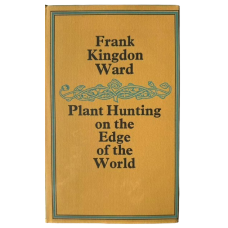In Plant Hunting on the Edge of the World, Frank Kingdon-Ward takes readers on a vivid journey through the rugged landscapes of Assam and Upper Burma in the early 20th century. Combining the rigors of scientific exploration with lyrical prose, Ward documents his search for rare and exotic plants in regions virtually untouched by Western science. From dense jungles to mist-covered mountain passes, he braves monsoons, leeches, and political unrest to uncover botanical treasures such as rare orchids, rhododendrons, and lilies. More than a catalog of discoveries, the book captures the spirit of adventure and the deep curiosity that drove Ward’s expeditions. His detailed observations of flora, terrain, and local cultures offer a rare window into a fading world. Plant Hunting on the Edge of the World is both a naturalist’s field report and a memoir of exploration, reflecting Ward’s passion for discovery and the beauty of nature in its wildest forms.
Frank Kingdon-Ward was a British botanist, explorer, and writer known for his daring plant-hunting expeditions across Asia, introducing rare species like the blue poppy to the Western world.
Frank Kingdon-Ward's explorations in Yunnan were concentrated in some of the most remote and botanically rich areas of the province, especially along its northwestern frontier near the borders with Tibet and Burma (Myanmar). Key regions where he collected include:
1. Nujiang (Salween River) Valley
Ward explored the dramatic gorges and high ridges of the Nujiang River, where he discovered numerous alpine species. The steep terrain and deep valleys created a unique microclimate ideal for rhododendrons, orchids, and Meconopsis species.
2. Dulong (Derung) Valley
A rarely visited area during his time, the Dulong Valley was one of the most remote parts of Yunnan. Ward reached it through dangerous mountain passes and found untouched forests filled with rare plants. This area yielded many unique specimens.
3. Gaoligong Mountains
Stretching along the western edge of Yunnan, the Gaoligong range was a hotspot of plant diversity. Ward documented numerous new species from its montane forests and alpine meadows, benefiting from the range’s isolation and varied habitats.
4. Tengchong and Baoshan Areas
These lower-elevation regions served as base points or transit routes for Ward’s deeper expeditions. Even here, he found interesting subtropical flora and used the towns to gather supplies and communicate with sponsors back in England.
5. Tibetan Borderlands near Zhongdian (now Shangri-La)
In this ethnically Tibetan region of northern Yunnan, Ward found rich alpine pastures and meadows brimming with wildflowers. The elevation and seasonal snowmelt made it an ideal habitat for plants like lilies, primulas, and gentians.
The Minerva Press, 1974, very good condition with a good dust wrapper, green cloth, frontispiece, 15 black & white illustrations and 3 maps.
| Book Details | |
| Author | Frank Kingdon Ward |
| Publisher | The Minerva Press |
| Publication Date | 1974 |
| ISBN | 856360066 |
| Format | Hardcover |
| Dimensions | 15*25 |
| Pages | 224 |
| Language | English |
| Condition | Good |
Plant Hunting on the Edge of the World: Travels of a Naturalist in Assam and Upper Burma, by Frank Kingdon Ward
- Publisher: The Minerva Press
- ISBN: 856360066
- Availability: In Stock
-
US$30.00
Related Products
The Land of the Blue Poppy: Travels of a Naturalist in Eastern Tibet, by F. Kingdon Ward
The Land of the Blue Poppy is a captivating narrative that chronicles the author’s botanical expedit..
US$30.00
Tags: Plant Hunting on the Edge of the World: Travels of a Naturalist in Assam and Upper Burma, by Frank Kingdon Ward



